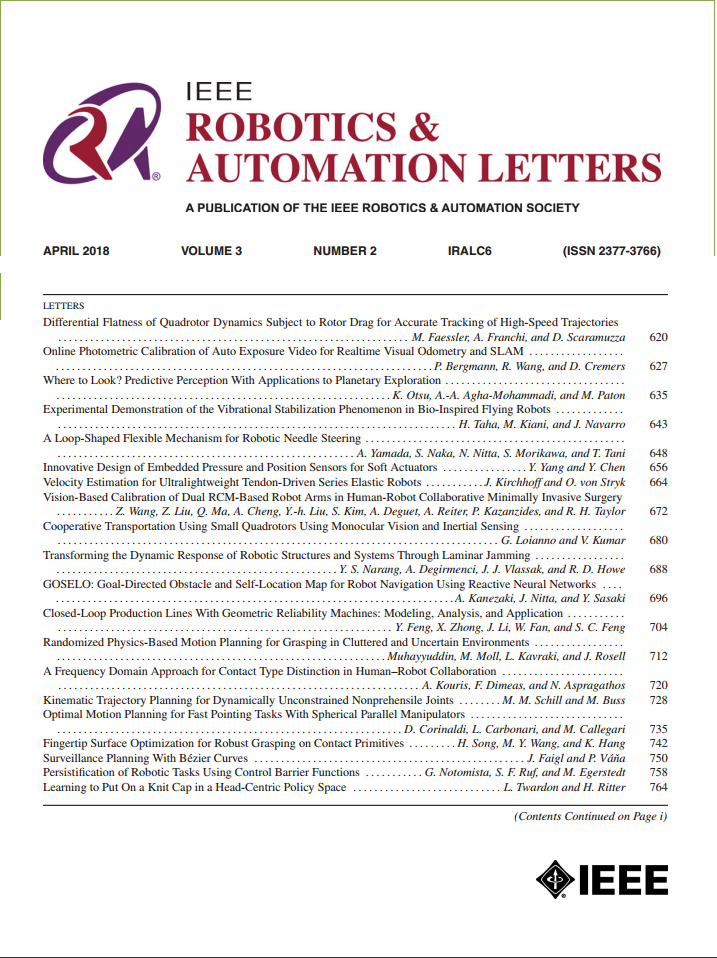反映股骨髁不对称运动的下肢外骨骼
IF 4.6
2区 计算机科学
Q2 ROBOTICS
引用次数: 0
摘要
人类膝关节具有不对称的生物力学结构,内侧髁大于外侧髁以支持负荷并促进多种运动,从而导致复杂的关节运动。这些复杂的生物力学特性经常导致膝关节和传统可穿戴机器人之间的运动学错位,导致运动受限,意外力和框架脱离。为了解决这些限制,我们提出了一种不对称的下肢外骨骼,在膝关节的内侧和外侧具有不同的特征,以适应膝关节的特征。外骨骼旨在均匀地分配施加在关节上的负荷,并自然地跟踪其复杂的运动。外骨骼反映了内侧的承重性能和外侧的灵活性。此外,它的框架结构支持内侧和外侧,以尽量减少膝盖的负荷。在内侧应用较少的自由度(DOFs)来分配关节上的载荷,而在外侧引入额外的自由度以实现灵活的运动跟踪。肌腱驱动驱动有助于膝关节运动,最大限度地减少关节体积和重量,并将关节与驱动器分离。实验结果表明,拟议的外骨骼改善了错位问题,并补充了佩戴者在行走时的肌肉力量,表明了其辅助和增强功能的潜力。本文章由计算机程序翻译,如有差异,请以英文原文为准。
Lower-Limb Exoskeleton Reflecting Asymmetric Movements of Femoral Condyle
The human knee has an asymmetric biomechanical structure, with the medial condyle being larger than the lateral condyle to support loads and facilitate diverse movements, thus leading to complex joint movements. These complex biomechanical properties often lead to kinematic misalignment between the knee joint and conventional wearable robots, resulting in restricted movement, unexpected forces, and frame disengagement. To address these limitations, we propose an asymmetric lower-limb exoskeleton with distinct features for the medial and lateral sides of the knee joint to suitably adapt to the knee characteristics. The exoskeleton aims to evenly distribute the load applied to the joint and naturally track its complex movements. The exoskeleton reflects the load-bearing properties of the medial side and the flexibility of the lateral side. Moreover, its frame structure supports both the medial and lateral sides to minimize the load on the knee. Fewer degrees of freedom (DOFs) are applied to the medial side to distribute the load on the joint, while additional DOFs are introduced in the lateral side for flexible movement tracking. Tendon-driven actuation assists knee motion, minimizes the joint volume and weight, and separates the joint from the actuator. Experimental results demonstrate that the proposed exoskeleton improves misalignment issues and complements the wearer's muscle strength during walking, indicating its potential for assistance and enhanced functionality.
求助全文
通过发布文献求助,成功后即可免费获取论文全文。
去求助
来源期刊

IEEE Robotics and Automation Letters
Computer Science-Computer Science Applications
CiteScore
9.60
自引率
15.40%
发文量
1428
期刊介绍:
The scope of this journal is to publish peer-reviewed articles that provide a timely and concise account of innovative research ideas and application results, reporting significant theoretical findings and application case studies in areas of robotics and automation.
 求助内容:
求助内容: 应助结果提醒方式:
应助结果提醒方式:


